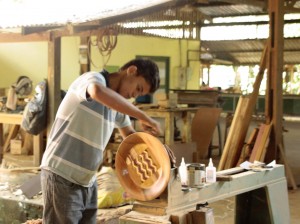By Miranda Chase’15
This has been a fantastic summer down here in the Amazon basin! The first time I was here was in 2011, and since then some things have changed a lot. Some others remain just as incredible as they have always been. As there are many stories to share, I will start with one today (and will write about others later). This is one of my favorites!
When we study coasts and communities, we try to break disciplinary boundaries, and we realize how important it is to have a holistic view of the world. This integrative approach is also adopted by Mr. Miguel Rocha- someone who doesn’t have disciplinary limits, and who has broken the boundaries of what used to be possible in rural Amazon many decades ago. His view of the world is not only holistic. It is inspirational.
I met him back in 2011, and this week I was having dinner with him and another friend. According to this friend, Mr. Miguel has a great voice to tell stories. I completely agree. So, please, imagine the following being told to you by a gentleman, in his 70’s, speaking slowly and softly:
The foundation was created in 1997. It is called Almerinda Malaquias Foundation. Almerinda was my mom, and Malaquias was my father. The idea has always been to create a center for environmental education and capacity building. Some years before that, I had met Jean-Daniel. He was travelling on my boat and later became my son-in-law. He shared my desire to create a foundation, and he was very skilled with wood working and other art crafts. We created the foundation together.
And the story goes on. Nowadays, almost 20 years later, the foundation has become a landmark and a cultural institution for the region. We are in the lower Negro River, right before it meets the Amazon River. The foundation is famous around here. Mr. Miguel and his partner have created it as a response to the challenges they saw here – and they did it in a non-disciplinary and holistic way.
The foundation has a partnership with the Ministry of the Environment. When the police confiscate wood from illegal logging, the trunks that have already been cut down are donated to the foundation. Unfortunately, it is still very hard for the government to eliminate illegal logging, so the foundation has no shortage of good quality hardwood. Nonetheless, they are already thinking ahead. Hopefully, at some point, illegal logging will be controlled and there will no longer be donations of wood. So the foundation is already planting a garden with fruit trees, medicinal plants, and other hardwoods. They are cataloging some plants that have not been fully studied yet. The fruits will be enjoyed by all visitors and students of the foundation, and the green park will be managed according to the demand for wood and the availability of other (donated) lumber.
The foundation offers capacity building training to locals in the lower Negro river. The workshops on woodcraft started almost 20 years ago, and have already “graduated” more than 500 artisans. More recently, the foundation also started teaching people how to make soaps, a task that has more directly benefited women (although women have been trained in the woodcraft workshops as well). Mr. Miguel told me that entire families join the classes at the foundation. This indicates how locals see this institution: it is a resource for them to acquire skills and gain a better livelihood. Their woodcraft products are sold all over the world. I have visited their local store, and here are some pictures.
So bear with me here: This project is teaching skills to local communities, which they find so valuable that they send entire families to the foundation, generating income to hundreds of people. This project makes use of wood that would, otherwise, be wasted. They are creating their own tree garden because they want a zero-deforestation future for the Amazon. Their capacity building workshops benefit men and women alike. Is there anything missing? Oh yes, they have a project where they educate children about the importance of the forest!
Do you want more? Here you go: They have never received not even a penny from the government, from local politicians, nor from religious groups. They want independence in order to guarantee their commitment to serving local communities without targeting any group in particular. All their funding comes from small private donations from friends and supporters worldwide. They have received three times an independent prize that awards the top 100 non-profit organizations in Brazil (there is no funding involved, but this is a huge recognition!).
Creating institutions in the Amazon is really hard. There is lack of funding, mistrust, skepticism and a host of parties that are not interested in the prosperity of sustainable initiatives. Numerous NGO’s are created every year, and years later they shut down their facilities. The Almerinda Malaquias Foundation has achieved more than what anyone thought to be possible 20 years ago, and what is still hard nowadays.
This all sounds incredible, fascinating and inspiring. You must have had many difficulties along the way. What do you think of this journey? I asked. Mr. Miguel said:
When outsiders come to visit the forest, they normally wear old shoes and clothes because they don’t want their good clothes to get dirty. When they go to a church, they wear nice clothes in order to pay a tribute to God. When I come to the forest, I wear my best clothes. This is a temple for me. Everything I do, and all the hardships I endure have one purpose: The Amazon forest and its peoples.

